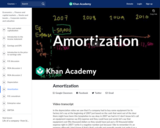
Introduction to amortization. Created by Sal Khan.
- Subject:
- Economics
- Social Science
- Material Type:
- Lesson
- Provider:
- Khan Academy
- Provider Set:
- Khan Academy
- Author:
- Sal Khan
- Date Added:
- 07/27/2021

Introduction to amortization. Created by Sal Khan.
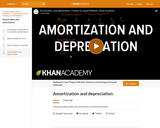
Comparing depreciation and amortization. Created by Sal Khan.

Learn about emotional intelligence and the role that the amygdala plays.

This lesson follows the NGSS standards for reviewing analog and digital waves. Students will be able to review the differences and similarities of analog and digital waves. Students will also be able to review how signals sent as analog or digital waves are used.

This lesson follows the NGSS standards for reviewing analog and digital waves. Students will be able to review the differences and similarities of analog and digital waves. Students will also be able to review how signals sent as analog or digital waves are used.

Ce cours traite des éléments liés au milieu physique et plus précisément l'espace physique rural et les méthodes utilisées pour l'analyse de ces milieux,يتناول هذا المساق العناصر المتعلقة بالبيئة المادية وبشكل أكثر تحديدا الفضاء المادي الريفي والأساليب المستخدمة لتحليل هذه البيئات

This lesson explores authors craft and sturcture through and event that directly effects students.

This lesson focuses on the vocabulary and skills students need to define, identify, discuss and apply a variety of informative writing techniques. The texts in this lesson are infographics related to marginalized people. Students are asked to apply the techniques they learn to an informative text of their own.
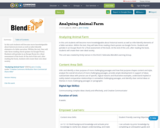
In this unit students will become more knowledgeable about historical events as well as infer/identify elements of a fable narration. Within the text, they will take three reading check quizzes via Google Forms. Students will partake in an Escape Room for a final assessment of the book. At the end of this unit, after reading the book, students will create their own ideal society.
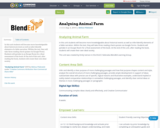
In this unit students will become more knowledgeable about historical events as well as infer/identify elements of a fable narration. Within the text, they will take three reading check quizzes via Google Forms. Students will partake in an Escape Room for a final assessment of the book. At the end of this unit, after reading the book, students will create their own ideal society.

The webinar features Dr. Joshua Rosenberg from the University of Tennessee, Knoxville and Dr. Cynthia D’Angelo from the University of Illinois at Urbana-Champaign discussing best practices examples for using R. They will present: a) general strategies for using R to analyze educational data and b) accessing and using data on the Open Science Framework (OSF) with R via the osfr package. This session is for those both new to R and those with R experience looking to learn more about strategies and workflows that can help to make it possible to analyze data in a more transparent, reliable, and trustworthy way.

Images can be a useful component in any subject. This lesson will guide students through an analysis of an image. Students will use critical thinksing skills to interpret an image. Students will then generate a hypothesis about the source and construct questions for further investigation.

Students will analyze photos for specific details that reveal the owner of a specific room.Then the analysis will include literature but will focus on literary devices and connotations.Also, students will have the opportunity to summarize text and then use evidence to support specific connotations.

An example of simplifying a seemingly complicated resistor circuit. Created by Willy McAllister.

This online activity shows how to use FRED, the Federal Reserve's free online economic data website, to analyze changes in real gross domestic product (GDP) and GDP makeup over time. Following simple instructions, you will locate spending data for the individual components of real GDP, and then combine them into a highly informative area graph. You will also use FRED's ability to stack data and see how trade—imports and exports—contributes to GDP. The resulting customized graph will let you see how economic output varies from year to year.

These activities ask students to engage with the question of what an equitable school calendar looks like and how to make their own school calendar more inclusive.

Students will learn about the basics of sexual and reproductive anatomy, as well as periods and menstrual care. This lesson is not intended to be divided by gender. We recommend all students learn together, as there is value in understanding all body types and functions, additionally this practice can help students de-stigmatize the natural variations in bodies and experiences.

This lesson provides a brief overview of sexual and reproductive anatomy, and explains how to complete self exams of breasts and testicles. It reviews the basics of reproduction, and introduces the many ways of becoming parents. The final activity asks students to consider the many responsibilities of becoming a parent.
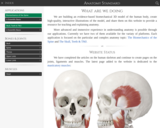
This website has an extensive collection of images of the skeleton. There are high-quality images with Latin labels and no labels. You can also find these images on the Anatomy Tool website in an easily downloadable format.

Lab Reference to accompany Openstax Anatomy & Physiology.